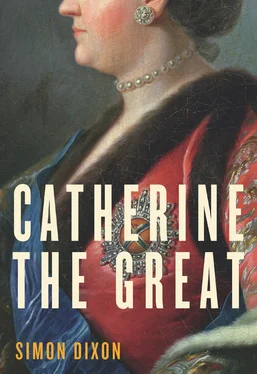At the heart of the cathedral, within full view of all three stands, twelve steps led up to a dais, six feet high, fourteen feet long and five and a half feet wide, draped in red velvet and surrounded by balustrades carved with gilded hieroglyphs. Catherine’s throne had been sent from Persia for Tsar Boris Godunov at the end of the sixteenth century. To its right stood a gilded table for her regalia; to the left was a place for the young tsarevich. Above the throne, a huge velvet canopy, decorated with gold braid and fringed with lace, was suspended from the ceiling by a chain, joined to each corner by silken ropes in the shape of a pyramid. Into the lining of this canopy was sewn the imperial coat of arms, so that the empress, should she glance to the heavens during her coronation, would stare straight into the eyes of a double-headed eagle. 61
By combining his knowledge of Renaissance engineering with rare sensitivity to Russian tradition, Fioravanti had created a building whose conventional exterior, modelled on the twelfth-century Cathedral of the Dormition in Vladimir, concealed one of the lightest and most spacious interiors in the Orthodox world. Yet it was by no means so cavernous as it was made to seem in the commemorative illustrations of Catherine’s coronation by Jean-Louis de Veilly, a French artist who had had a chequered career since arriving in St Petersburg from England in 1754. (His appointment to teach at the Academy of Fine Arts was terminated ‘thanks to the peculiarities of his character’ and the figures he painted on the floor of the Chinese Room at Tsarskoye Selo seemed ‘flushed and somehow drunken because of their slitty eyes’. 62) De Veilly evidently used illustrations of the Bourbon coronations as one of his models. But even had the Orthodox Church permitted the use of musical instruments to accompany the liturgy, there would scarcely have been room for the 100-piece orchestra hidden behind the altar at Reims for the coronation of Louis XVI in 1775. 63Barely a quarter of the size of Reims or Westminster Abbey, and much more intimate in atmosphere, the Dormition Cathedral had only limited space for guests. Competition for places was intensified by two eighteenth-century developments: the expansion of the noble elite and Peter the Great’s insistence that both sexes should attend Court ceremonials in a church conceived by its Muscovite founders as a strictly male preserve.
Catherine’s nineteen-year-old friend, Princess Dashkova, who might have expected to benefit from the new dispensations, was mortified to discover that instead they militated against her. Having travelled from St Petersburg in the empress’s own carriage, Dashkova found that her membership of the Order of St Catherine, to which only thirteen candidates had been appointed during Elizabeth’s twenty-year reign, counted for nothing at a ceremony where precedence depended on rank alone. As the wife of a mere colonel, the most junior officer admitted to the coronation, the princess was relegated to the back of the stand, even though her husband, as one of the two masters of ceremonies, had the honour of leading the procession of the imperial regalia from the Senate Palace, where they had been stored overnight, to the Palace of Facets. 64The slight still rankled when Dashkova came to write her self-serving memoirs in 1804. Blaming her humiliation on the Orlovs, who distrusted her as the younger sister of Peter III’s disgraced mistress, Elizabeth Vorontsova, she was forced to swallow her pride or absent herself altogether, as friends advised her to do. There was never really a choice. ‘I said to myself that if they were putting on an opera I wanted to see and the only seats were in the gods, then I should, as a passionate music-lover, take my place there rather than miss the performance.’ 65
* * *
Catherine’s coronation was a performance in three acts, of which the first was purely liturgical. As the empress processed to kiss the icons before taking her seat on the throne, the choir chanted Psalm 101 from their specially constructed stalls to the side of the holy gates: ‘I will sing of mercy and judgement: unto thee, O Lord, will I sing.’ 66By the time they reached King David’s final menacing verse—‘I will early destroy all the wicked of the land; that I may cut off all wicked doers from the city of the Lord’—there had been plenty of time for the congregation to contemplate the frescoes of the Last Judgement on the west wall. Though many of these masterpieces had been damaged by condensation—Catherine herself later paid for their renovation in the early 1770s 67—their message was given added urgency in a cathedral built at a time when many Muscovites anticipated the imminent end of the world in 1492 (the year 7000 according to the Byzantine calendar numbered from the Creation). 68Now that fears of the Apocalypse had subsided, Catherine’s courtiers were less inclined to dwell on divine punishment than on the rewards to be anticipated by the righteous. Though the empress may privately have mocked superstition, the overwhelming majority of her subjects, including many of the most eminent, never abandoned their belief in the power of icons and relics to cure all manner of afflictions. As the most important church in Muscovy, the Cathedral of the Dormition housed some of Orthodoxy’s most precious relics, including the head of John Chrysostom, the right hand of the apostle Andrew, one of Basil the Great’s fingers, part of a leg of St John the Baptist, and the remains of many lesser, local saints. 69
It mattered that the cathedral also contained the most famous miracle-working image in all Russia, the icon of Our Lady of Vladimir, because it had become an established literary convention to associate female Russian monarchs with the Virgin Mary. In sharp contrast to St Petersburg, Marian imagery was prominent all over Moscow, which claimed to have inherited the Virgin’s traditional role as protectress of Constantinople when the ‘second Rome’ fell to the Turks in 1453. (The church now famous as St Basil’s Cathedral at the southern end of Red Square was officially known as the Cathedral of the Protecting Veil of the Mother of God because it had been consecrated in memory of the fall of the Tatar stronghold of Kazan to Ivan the Terrible on the feast of the protective veil in 1552.) Orthodox writers who had celebrated the feast of the Nativity of the Mother of God as recently as 8 September now portrayed Catherine in the image of a virginal queen capable of restoring happiness and leading her people to paradise. But while it was convenient to associate the empress with the Virgin by virtue of her sex, her office led to analogies with Christ himself. Since the image of the sun king had been commonplace in absolute monarchies since the time of Louis XIV, there was nothing apparently extraordinary in Alexander Sumarokov’s depiction of Catherine, in the ode he dedicated to her ‘On the First Day of 1763’, as the light to drive out all darkness (by which he meant any surviving vestige of support for Peter III). Sophisticated Russian readers, however, would have had no difficulty in recognising an additional allusion to the transfigured Christ. Vasily Petrov, the empress’s ‘pocket poet’, later made still more explicit references to Catherine as ‘the beginning and end of all things’ and the ‘image of the all-powerful Deity’, pouring ‘light from [her] lofty throne’. 70Whilst the jewels in the empress’s regalia reflected hundreds of flickering candles and glinted in the pale light filtering through windows set high in the cathedral walls, the most important illumination at her coronation was that which radiated metaphorically from Catherine herself.
Only the most accomplished of actresses could have carried off the part of a Christ-like virgin queen when all present knew her as both an adulteress and a usurper and many suspected her of regicide to boot. Yet while the Russian elite suspended its disbelief in the face of the realities of power, Catherine’s theatrical talents were never in doubt. No less a rival than Louis XV acknowledged shortly before the coronation that her courage and powers of dissimulation marked her out as ‘a princess capable of planning and executing great deeds’. 71Unlike contemporaries unwisely tempted to regard coronations as so much mumbo-jumbo, Catherine was determined to take hers with all seriousness. Whereas Austria’s Francis Stephen had seemed playfully to wave his regalia during the procession that followed his installation as Holy Roman Emperor in 1740—a ceremony that his wife Maria Theresa dismissed as ‘a comedy’ 72—Catherine invested even those elements of the ritual in which she could scarcely believe with the dignity expected of a rightful sovereign, beginning with a confident public declaration of her adherence to the articles of the Orthodox faith. 73
Читать дальше












